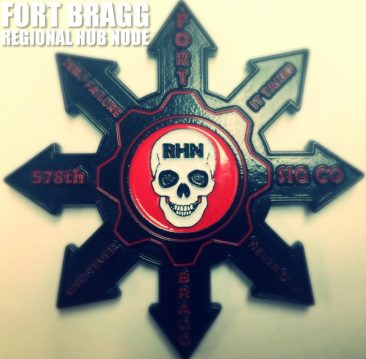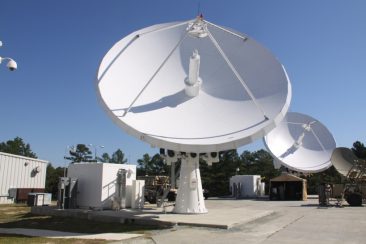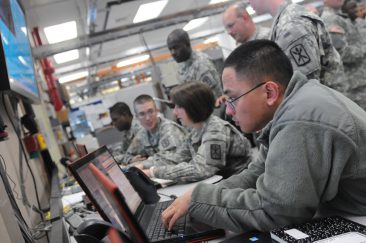The Fort Bragg Regional Hub satellite dishes

The Bragg RHN is one of five RHNs in the world – Guam RHN; Landstuhl RHN, Germany; Arifjan RHN, Kuwait; and Camp Roberts RHN, California. The Bragg RHN is part of the Earth Terminal Facility Complex located on Fort Bragg, North Carolina. Like the other RHNs throughout the world, the Bragg RHN supports contingency operations, disaster relief, and/or National emergency response. The RHN provides global data and voice services for deployed units and supports various scenarios and mission sets. The RHN is equipped with three Division Enclaves (DEs), with each enclave similar to the equipment set and capabilities of one Unit Hub Node (UHN); and twelve Separate Enclaves (SEs) for additional support and capabilities. The RHN is responsible for Time Division Multiple Access (TDMA) timing and control functions via four Network Control Center (NCC)/Master Reference Terminal (MRT) suites; one assigned per enclave with each providing local and remote redundancy. The RHN also supports Frequency Division Multiple Access (FDMA) connectivity as well as Net Centric Waveform (NCW) capabilities for Inc2 support and/or Inc1b interoperability. The designated Eastern Continental United States (CONUS) RHN has been on the forefront in introducing capability sets for WIN-T and becoming the first fully ‘Inc2’ capable RHN.
The Winds of Change
In 2011, The RHN was manned exclusively by contract personnel who worked in conjunction with the Node Site Coordinator to the facility and the RHN OIC, Network Management Technician, to conduct mission planning and operations. At that time, the RHN was supporting approximately 300 missions per year, and it had only been in operation approximately 12 months.

Photo By: U.S. Army Photo
Fast forward 12 months – late in the year, there were two big changes. First, the political machine was going through a decision making process to determine if the Network Service Center – Training (NSCT) located at Fort Gordon, Georgia was still required to be separately funded now that the RHNs (Fort Bragg and Camp Roberts) were online. Key personnel involved in the ‘conversations’ provided the statistics to all of the decision makers about the RHN’s capabilities and the level of support that was prepared to provide to the tactical user in the field. The NSCT was never intended to be a long term solution. PM WIN-T Inc1 had plans for the RHN prior to the fielding of the Joint Network Transport Capability – Spiral (JNTC-S) architecture, but it took longer to put the strategic facilities in place then it did to field the tactical system. Meanwhile, the NSCT had established itself as a reliable service provider and a lot of the higher stakeholders became concerned at the possible decrease in the level of support if there was a change. However, by the end of the discussions and debates, the RHN convinced all invested personnel that the Bragg RHN could hold the standard and assume the mission. So began the transition of the majority of the CONUS training missions to the Fort Bragg Regional Hub Node – which saw an increase of mission support by 400%.
The second change was the command philosophy at 7th Signal Command, which was very ‘operationally oriented’ and became the driving force in ensuring Soldiers assigned to the RHN would be directly involved in the RHN mission. At the same time, the contract for the RHN support was being renegotiated as it was set to expire. It was known that the manning requirements would be much higher with Soldiers working on the RHN and the level of support promised to keep was highly contingent upon having experienced operators assisting terminals in the field. There had to be a clear delineation between contractor responsibilities and Soldier responsibilities. The solution – segment the ‘mission’ into three phases: Pre-mission, Mission Execution, and Post-mission.
The ‘Pre-mission’ preparation involves the configuration and setup of the mission by the contractors, which is done in accordance to the approved and issued mission documentation – the Army Service Authorization (ASA) for services (by Network Command (NETCOM)) and the Satellite Access Authorization (SAA) for satellite access (by the Regional Satellite Support Center (RSSC)). The ‘Mission Execution’ involves the operations portion of the mission, and the Soldiers (Tier-I controller support) provide the function of servicing the calls and assist in routine troubleshooting and terminal access/de-access procedures. The contractors provide the Tier-II technical support element in the event troubleshooting exceeded the scope of Tier-I and/or exceeded the provided documentation that has been pre-configured.
The RHN Prepares for Battle!
With the contract settled, the next step was to prepare for the integration of the Soldiers at the RHN, which was scheduled to take place when the contract transitioned on April 21, 2013. The 23 Soldiers assigned to the RHN, according to the MTOE, began classes provided by Communications-Electronics Command (CECOM) in order to prepare them for the ‘fight’. The received ‘RHN specific training’ was basic networking, advanced networking, VoIP, and NCC/MRT & SatCom training. With the disposition of the Soldiers at the time (consisting of MOS 25Ss, 25Bs, and 25Ns), there were only a handful of personnel, besides the Network Management Technician, who had experience with JNNs and CPNs – let alone versed in the deployment and operations of tactical systems. Processes and tactics, techniques, and procedures (TTPs) had to be developed and implemented in order to bridge the gap between experience and training.
One process is the Site Certification Program (SCP), which is a 90-day program designed to inform and baseline the knowledge-base of incoming personnel in all major functional areas at the RHN (baseband function, SatCom function, Systems Control (SYSCON) function, and Network Operations function), regardless of background and specialty. The SCP is a hybrid program consisting of an abbreviated Network University with the majority of the program consisting of on the job training (OJT). The intent is to ensure Soldiers are prepared to hit the ground running at the end of the 90-day period. Some products implemented at the RHN to mitigate ‘inexperience’ and ‘simple knowledge-base’ are quick reference guides (QRGs) or ‘Spark Charts’ the controllers have as a resource that covers almost any and all basic troubleshooting from the perspective of the terminal and from the perspective of the RHN.
Additionally, there is a very practical and detailed trouble ticketing system that is referred to as the Incident Management Report (IMR) that is used for each and every phone call serviced – capturing everything that is said and/or done by both the controller and the distant end operator. The records created are then committed to the Master Station Log (MSL), and the actual IMR document is saved as part of the mission archive.
MOS Neutral
With all the aforementioned processes, products, and TTPs in place, the ultimate goal with them (and continues to be) is to provide the most efficient and flexible support to the customer – no matter the issue that they present to us. The Soldiers at the RHN are charged to be proficient in every node and terminal throughout the WIN-T inventory from SIPR/NIPR Access Point (SNAP) terminals to the Tactical Communication Node (TCN) Inc2 to legacy systems like the AN/TSC-156 Phoenix terminal. They are expected to be knowledgeable in both baseband and satellite communications and to be a multi-skilled controller. It is overwhelming, challenging, demanding… and at times, unforgiving.
Tiers for Fears
The Soldiers are taught to be methodical when troubleshooting and approach problems systematically – and for a good reason. There is always a high volume of incoming calls at the RHN and a myriad of issues are serviced daily. It can be a daunting task for an inexperienced Soldier to isolate network issues and restore communications in a relatively short period of time. The pressure and stress can stack and become overwhelming for a Soldier that is not familiar with the equipment; especially if a Soldier is not trained in a particular area. To mitigate the chaos and alleviate some of the pressure, the RHN has implemented a very robust tiered troubleshooting system. The Soldiers are considered Tier-1 in the troubleshooting process at the RHN and their job is to assist a customer within the ‘boundaries’ of the issued mission documentation. For every call serviced at the RHN, each controller has to decipher the customer’s problem. Not everyone is created equal and not every problem or issue is clearly conveyed to the controllers, so it is the unique and demanding task of the controllers to determine the problem and begin ‘network forensics’ to isolate and resolve the issue(s).

Photo Credit: Liana Mayo, 311th Signal Command
Any issues identified that deviates from the baseline configuration and/or from the configurations inputted by the technicians (Tier-2) are handled by the contractors, which are the backbone of the operations. The PM might be configuration managers, but the contractors are the ‘guardians’ of the configurations and ensure ‘configuration integrity’ is maintained across the board.
Any issues that exceed the scope of the Tier-2 technicians are escalated to the Tier-3 engineers. The Tier-3 engineers are considered the ‘safety net’ for the controllers and technicians and really solidify the RHN’s ability to provide the best and most efficient support that can be provided. The RHN is not only a node that functions to terminate communications and services, but it is there to advise, assist, and be a source of knowledge. The RHN is a 24-hour operations facility and there is always someone on duty that can help whether it is troubleshooting DHCP problems or asking how to convert a colorless core to a NIPR core.
In the last year alone, with Soldiers and contractors, the RHN has successfully supported 1,614 missions; including Joint Readiness Training Center (JRTC) missions, Joint Operational Access Exercises (JOAXs), and numerous Grecian Firebolt National Guard missions. The success rate is over 97% based on post mission After Action Reviews (AARs) provided by the customer.
The Network Management Technician
The Regional Hub Node is definitely a broadening assignment. A Network Management Technician is responsible for the daily operations of the facility and overall manages the various sections and planning cell through every phase of operation, from mission request to mission teardown. The primary duty is keeping the cogs in the wheel turning and never let the mission fail.
The Net Tech dialogs, on a daily basis, with higher echelon personnel and agencies regarding the day-to-day operations and support offered by the RHN. There are several stakeholder discussions that highlight how the Army will be supported in terms of communications and resources (near and short term), and the Net Tech is the focal point that drives these discussions. The RHN is a strategic facility that operates with a ‘tactical’ mindset, essentially experiencing the best of both worlds in terms of career progression and relevancy. It is one of the most influential jobs and has a rewarding opportunity to make positive changes for the community. The Net Tech communicates with Net Techs across all three Compos and caters to the technical needs and requirements of our comrades.
The Perfect Storm
The RHN operates in a perfect storm and has been doing so, successfully, for quite some time. It is a mystical and magical place to some people comprised of unicorns and rainbows; to others a place of chaos. It is referred to as the pure fluffy magic (PFM) cloud or ‘those guys’ sitting quietly waiting for things to happen. The RHN has embraced the ‘distant end’ moniker and strives to remove the stigma of ‘it’s the distant end’s fault’ that permeates throughout our community. It is an uphill battle; however, it is a battle that we will continue to support. The controllers and technicians understand that some customers will call blaming the RHN and we are in the business to NOT point fingers, but to simply work as a team and figure out what the problem is. If the RHN is at fault, then we openly admit it, make notes, and adjust accordingly. The RHN is in the business of making sure the mission is a success and if the mission fails, then we have failed too.
We do whatever it takes… zero failure, never quit!

This was really interesting and useful. I have interacted with both Bragg and Roberts and they are functionally a black box from the operators side, neat to see how they came to be and how they operate internally.